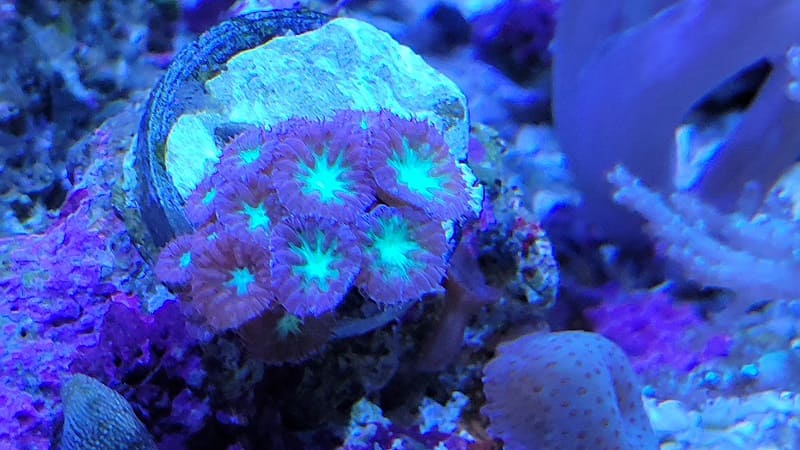As reef enthusiasts, there’s something truly gratifying about watching our coral colonies grow and thrive. Fragging, short for fragmenting, is a popular practice among aquarium hobbyists to propagate and share their beloved corals with others. In this guide, we’ll delve into the fascinating world of fragging Purple & Green Blastomussa corals. We’ll explore the techniques, tools, and precautions necessary to ensure a successful and responsible coral propagation process.
I. Understanding Fragging and Its Importance
Fragging is the process of carefully breaking off a portion of a coral colony to create a new individual, known as a “frag,” which can then grow independently. This practice plays a crucial role in coral conservation efforts and allows reef enthusiasts to share their favorite corals without depleting natural populations.
II. Preparation and Safety Measures
Before embarking on the fragging journey, it’s essential to gather the necessary equipment and take proper safety precautions:
A. Equipment
- Safety gloves: Protect your hands from potential irritants or harmful substances.
- Safety goggles: Shield your eyes from coral fragments and potential splashes.
- Fragging tools: Invest in specialized coral fragging tools like bone cutters, coral bone shears, or a diamond bandsaw.
- Frag plugs or live rocks: These will serve as the new homes for your coral frags.
- Glue or epoxy: Use reef-safe glue or epoxy to secure the frags onto their new bases.
B. Safety Measures
Work in a well-ventilated area: Ensure good air circulation to avoid inhaling any fumes from the coral or adhesives.
Handle corals carefully: Avoid damaging the parent colony during the fragging process.
Dispose of waste responsibly: Collect and discard any coral debris safely to prevent potential harm to other marine life.
III. Fragging Techniques for Purple & Green Blastomussa Coral
The Purple & Green Blastomussa coral can be fragged using two common methods: the cutting method and the division method.
A. Cutting Method
Select a healthy parent colony: Choose a mature and thriving coral colony as the source for your frags.
Secure the parent colony: Gently secure the parent colony to prevent any unnecessary movement during fragging.
Make clean cuts: Using the appropriate fragging tool, carefully make clean cuts across the coral’s ridges, ensuring each frag contains multiple polyps for better chances of survival.
Dip the frags: After fragging, it’s essential to dip the frags in a coral dip solution to remove any potential pests or parasites.
Attach frags to frag plugs: Apply reef-safe glue or epoxy to the base of each frag and attach them securely to frag plugs or live rocks.
B. Division Method
Identify natural division points: Observe the natural separations or gaps between individual polyps on the parent colony.
Gently separate the polyps: Using your fingers or fragging tools, gently separate the polyps along these division points.
Rinse the frags: Rinse the separated polyps in a coral dip solution to ensure they are clean and free from any contaminants.
Attach frags to frag plugs: Apply reef-safe glue or epoxy to the base of each separated polyp and attach them firmly to frag plugs or live rocks.
IV. Post-Fragging Care
After successfully fragging your Purple & Green Blastomussa coral, it’s crucial to provide proper post-fragging care to ensure the frags’ successful acclimation and growth.
Water quality: Maintain stable water parameters, including temperature, pH, and salinity, to minimize stress on the frags.
Lighting and flow: Position the frags in an area with appropriate lighting and moderate water flow to support their photosynthesis and growth.
Monitoring: Regularly monitor the frags for signs of distress or pests, and address any issues promptly.
V. Celebrating the Growth of New Colonies
As the newly fragged Purple & Green Blastomussa corals grow and flourish, you’ll witness the beauty and success of your propagation efforts. Fragging allows you to expand your coral collection responsibly and contribute to the conservation of these captivating corals in the marine hobbyist community.
Conclusion
Fragging Purple & Green Blastomussa corals can be a gratifying and rewarding experience for aquarium enthusiasts. By understanding the fragging techniques, taking necessary precautions, and providing proper care, you can contribute to coral conservation while sharing the mesmerizing beauty of these corals with fellow reef enthusiasts. Remember, responsible fragging practices play a significant role in maintaining the delicate balance of our aquarium ecosystems and preserving the natural wonders of the underwater world.

